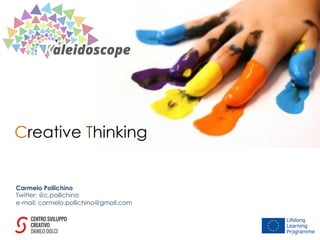
Creative thinking presentation kaleidoscope
- 1. Creative Thinking Carmelo Pollichino Twitter: @c.pollichino e-mail: carmelo.pollichino@gmail.com
- 2. Mechanism of our brain
- 3. Thinking is a voluntary action Intelligence Thinking ≠ Critical Thinking Creative Thinking ≠ !
- 4. Intelligence (engine) is a potential Thinking (driver) is an operative skill
- 5. Critical Thinking Creative Thinking • Analytical • Judgmental • Selective • Probability • Left brain • Yes but… • Generative • Non-judgmental • Expansive • Possibility • Right brain • Yes and…
- 7. with critical thinking you can find wrong answers with creative thinking you can find wrong questions
- 8. When you are thinking critically you are making choices When you think creatively you are exploring many new ideas
- 9. Thinking process is like a kayak with 2 paddles, one is creative thinking while the other rapresents critical thinking
- 10. START SOLUTION Step 1 Step 2 Step 3 Step 4 ERROR! Linear Model
- 11. START Step Step Step Step Step Step Step Step Step Step Step Step Step SOLUTION BEST SOLUTION NEW IDEA Random Model
- 13. Creative Thinking in 3 steps
- 14. Set the brain in positive thinking #1
- 15. 80% of the brain is dedicated to visual processing #2
- 16. The dream education center Finish (video)
- 18. Six Thinking Hats® The main difficulty of thinking is confusion emotions informations logic hope creativity Help to do one thing at a time Create a map of think
- 19. Six Thinking Hats® www.debonofounda7on.co.uk www.skills4me.eu
- 22. White Hat Informa7on • Informa7on we know • Informa7on we need • How are we going to get that informa7on? • Determines accuracy and relevance • Look at Other People’s Views (O.P.V.)
- 23. Red Hat Feelings, Intui7on, Gut Ins7nct • Permission to express feelings • No need to jus7fy • Represents feelings right now • Keep it short • A key ingredient in decision making
- 24. Black Hat Risks, Difficul7es and Problems • The skep7cal view • Reasons must be given • Points out Thinking that does not fit the facts, experience, regula7ons, strategy, values • Points out poten7al problems
- 25. Yellow Hat • Benefits and The op7mis7c view • Reasons must be given • Needs more effort than the black hat • Find the benefits and values • Considers both short and long-‐ term perspec7ves Benefits and Feasibility
- 26. Green Hat New Ideas, Possibili7es • Crea7ve thinking • Seeks alterna7ves and possibili7es • Removes faults • Doesn’t have to be logical • Generates new concepts
- 27. Blue Hat Managing the Thinking • “Control” hat • Organizes the thinking • Sets the focus and agenda • Summarizes and concludes • Ensures that the rules are observed
- 28. Informa7on Feelings, Intui7on, Gut Ins7nct Risks, Difficul7es and Problems Benefits and Feasibility New Ideas, Possibili7es Managing the Thinking
- 30. The Four Rules 1. Whoever come are the right people. 2. Whatever happens is the only thing that could have. 3. Whenever it starts is the right time. 4. When it’s over, it’s over. The law of two feet Open Space Technology (Harrison Owen)
- 31. Carmelo Pollichino Twitter: @c.pollichino e-mail: carmelo.pollichino@gmail.com
